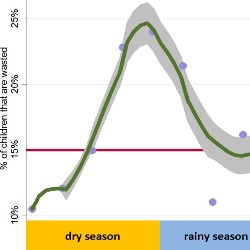The USAID Famine Early Warning System (FEWS-NET) periodically assesses famine risk across several countries. However, FEWS-NET predictions are not updated in real-time and reports provide insufficient information on risk factors driving conditions of acute malnutrition. While famine has a technical definition, the declaration of famine often manifests a political process that may lack transparency. Our research investigates how a variety of socioeconomic risk factors can be used to develop near-term forecasts of food insecurity as a tool for early-warning famine declarations.

Famine Decision-Making Techniques
Malnutrition data are essential to assess the severity of a humanitarian crisis and guide decision-making for aid assistance. However, in low-income countries, data are frequently missing or inconsistent, limiting the ability to establish spatiotemporal variations both between and within years. Robust assessment of food insecurity in all its forms depends on the quality and completeness of primary data, and the lack of timeliness leads to a significant lag time between observed worsening conditions and political and humanitarian actions. Improved understanding of these trends can contribute to our knowledge of the drivers of malnutrition and how those drivers might vary over time and space.
- Venkat A, Simpson RB, Marshak A, Naumova EN. (2019). Complex Decision-Making Rules for Famine Forecasting. 17th Annual Freeman Symposium on Infectious Diseases. Harvard University. Cambridge, MA. (Poster Presentation)
- Venkat A, Marshak A, Naumova EN. (2018). Periodic Variations in Malnutrition Indicators: Evidence from SMART Surveys in the Sahel. American Society for Nutrition 2018 Conference. American Society for Nutrition. Boston, MA. (Poster Presentation)
.